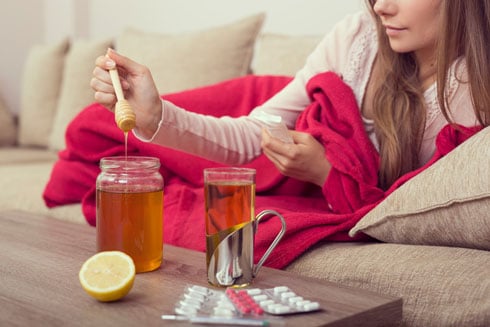When someone in your house gets the flu, you probably say to yourself, “I’m next.”
That’s understandable. The flu virus is relentless. Every time a flu sufferer coughs, it propels the viruses six feet in the air. When the viruses land on any surface, they can infect anyone who touches them for up to 24 hours.
But there are steps you can take to reduce your risk. Here are the five best ways to thwart the flu virus when a family member gets sick.
1. You’ve Heard It Before, But It’s True…
Handwashing is the single most important preventive measure you can take.1
Wash your hands after every contact with the sick person, their room and bathroom, and any items he or she has used…like a dish, cup, or towel.
Don’t touch your face before washing your hands. This is easier said than done. On average, people touch their face two or three times a minute, which grants the flu virus easy access through your eyes, nose, and mouth. Make a conscious effort to avoid doing this.
Here’s the best technique for washing hands.
Don’t use soaps labeled “anti-bacterial” or “anti-microbial.” They are not any more effective than plain soap. And they likely contain triclosan. It’s a chemical linked to a cancer and thyroid problems.
Keep alcohol-based hand sanitizer at the ready for times when handwashing is inconvenient or you don’t have access to a faucet.
2. Create a Sick Room
Quarantine may seem cruel, but you can drastically reduce the risk of infection by keeping your sick relative in a separate bedroom away from common areas like the kitchen and family room. If possible, restrict him or her to a separate bathroom that everyone else avoids for the duration of the illness.2
Only one person—a designated caregiver—should have access to these areas. The sick room should be stocked with essential items such as tissues, a trash can, medicine, and bottles of water.
The designated caregiver should avoid face-to-face contact with the sick person. When holding sick children, it’s important to place their chin on your shoulder so they will not cough in your face.
Sick people should be encouraged to cover their mouths and nose with a tissue and put the tissue in the trash right away. If a tissue is not available, they should be encouraged to cough or sneeze into the crook of their elbow, not their hand.3
3. Forget Sharing
That means not sharing any personal items. These include:
- Food, drinking glasses, and utensils
- Combs, brushes, and clothing (including hats and scarves)
- Washcloths and towels
- Pillows and blankets
- Phones and TV remotes
- Toys and computers
And keep the sick person’s toothbrush separate from other toothbrushes. Throw it away after the person has recovered to prevent re-infection.
4. Sanitize Surfaces
Clean all sickroom surfaces—including bedside tables, doorknobs, and toys—with a disinfectant, disinfecting wipes, or a solution of ¼ cup bleach mixed in one gallon of water.4
Collect all soiled sheets and towels in a laundry basket. Don’t carry them in your arms. Wash and dry on the hot setting.
Be sure to quickly dispose of tissues. Afterward, thoroughly wash your hands.
5. Boost Your Wellness Routine
To keep your immune system in top shape, eat a healthy diet that includes plenty of fruits and vegetables and enough water to prevent dehydration. Exercise every day and get 7-9 hours of sleep a night.6
Research shows adequate vitamin D3 prevents the flu. And if you do get the flu, vitamin D3 can greatly reduce the severity. Take a 5,000 IU supplement daily during flu season.
Vitamin C is a powerful immune booster that prevents contagious diseases from taking hold in your body. Studies show that a 3,000 mg daily supplement reduces cold and flu symptoms by 85%.
These measures are likely to be more effective than the flu shot.
Last winter, the vaccine was only 42% effective. It was almost completely ineffective in seniors. And they are the ones who need it most. People 65 and older are hardest hit by the flu. They suffer the most deaths and hospitalizations.7
Vaccines against other infectious diseases are not considered successful unless they are at least 90% effective. But over the last 10 years, the flu shot has had an average effectiveness rate of only 46%. In four of the last five seasons, the vaccine has been largely worthless for seniors.
Editor’s Note: There are 31 secrets that build your immune system… And we’ve put them all together for you in our report, Bulletproof Your Immunity: Easy Ways to Protect Your Health. Get all the details HERE.
Like this Article? Forward this article here or Share on Facebook.
References:
1 https://consumer.healthday.com/respiratory-and-allergy-information-2/common-cold-news-142/when-a-cold-or-flu-strikes-a-family-member-725759.html
2 https://www.cdc.gov/flu/consumer/caring-for-someone.htm
3 https://www.cdc.gov/flu/takingcare.htm
4 https://symptoms.webmd.com/cold-flu-map/stop-spread-cold-flu
5 https://www.webmd.com/cold-and-flu/features/stop-spread-cold-flu1#1
6 https://www.everydayhealth.com/hs/fight-colds-and-flu/help-family-stay-healthy/
7 https://www.institutefornaturalhealing.com/2017/09/australias-bad-flu-season-means/

